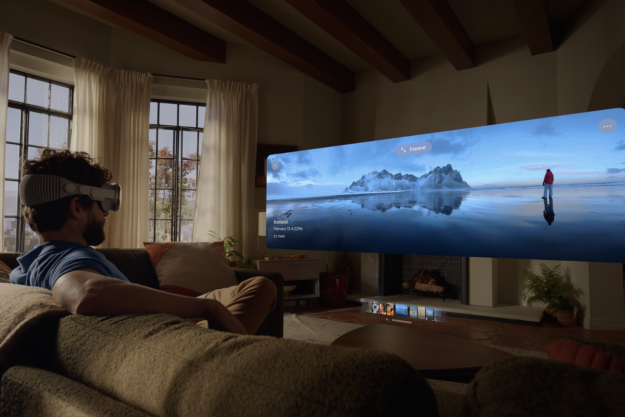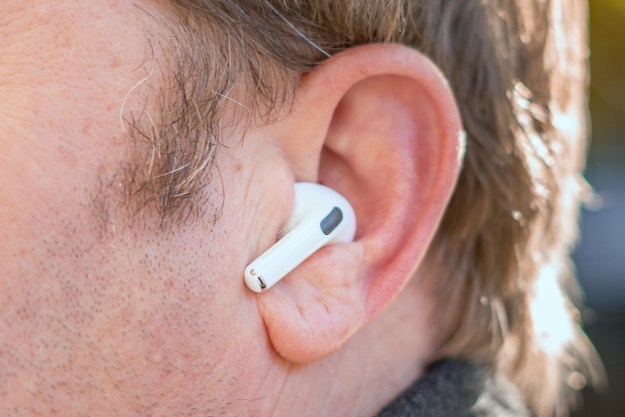For months ahead of its release, people have asked if I thought the Apple Vision Pro might be the next frontier for watching movies and TV shows and playing video games. Will it be better than watching the best TV? Will it be better than watching a movie on a projector and screen? Is the Apple Vision Pro going to be better than the best movie theater you can visit?
My answer has always been a resounding no. My potent powers of tech punditry and prediction allowed me to determine — without having tried the Apple Vision Pro — that it would never be able to replace a quality home entertainment system, let alone a premium commercial theater. And there was one very important reason why.
Was I right? Or am I about to eat a big fat slice of humble pie? Let’s find out.
To be clear, this is not an Apple Vision Pro review because you don’t need another Apple Vision Pro review. At least not from me.

I’m here to talk about the merits of the Apple Vision Pro as a replacement or alternative to your TV, projector, or home theater system in a way I’ve not seen others do.
But there’s more. See, the Apple Vision Pro is capable of doing something for watching movies that no other home entertainment device can do — yet — and nobody is talking about it. But it’s a game changer.
Before I discuss the sight and sound experience you get with the Apple Vision Pro and compare it to other forms of AV entertainment, I need to tell you a bit about my experience with this device. It’s crucial you understand that for context, but I also have a responsibility to tell you in the interests of sound journalism.
Handoff headaches
The Apple Vision Pro I used is not my Apple Vision Pro. The headset was lent to me by someone else because they wanted me to experience something very specific — that thing nobody is talking about that we’re going to talk about. And if you know anything about the Apple Vision Pro, then you know this device isn’t set up well for sharing. It does have a guest mode, yes, but that guest mode presumes the owner is around to make a handoff. And for the vast majority of the time I’ve been using the Vision Pro — or at least trying to use it — the owner has not been here. And that’s made using this thing challenging, to say the least.
I got to see what everyone else has been seeing. And … wow. Just … wow.
The first few hours of using the Vision Pro were extremely unpleasant for me. So much so that for a couple of days, I dreaded the idea of putting it on. I wanted so much to just pack it back in its box and send it on its merry way. But I’m glad I kept after it.
As you may have heard, the $3,500 Vision Pro is designed to be customized for one user. From the light guard to the eye-tracking tech to the Apple account it’s tied to, it’s really meant to be bespoke for one. When I put this Vision Pro on, it’s expecting someone else. The lenses inside are calibrated for someone else’s eyes, carefully spaced to line up the focal point of the lenses to that person’s pupillary distance, or PD — a term I learned in a prior life as a licensed optician. (Yes, really, I was a licensed optician while in college.)
Anyway, just entering the PIN code to unlock this thing was among the most frustrating and infuriating experiences I’ve ever endured because it couldn’t track my eyes correctly, and I couldn’t pinch on the correct numbers. Even when I managed to get it unlocked, it never felt like it was working right. It always felt like it was for someone else. Like wearing someone else’s prescription glasses, even though this Vision Pro doesn’t have prescription lenses you can put in. It just felt like putting on someone else’s glasses.

It got to the point where wearing the Vision Pro made me feel sick. And I don’t mean just a little queasy, I mean that I was basically useless for a couple of hours after wearing this thing for just 10 minutes.
There were times I wanted to throw it across the room, especially because if I dared take it off, I would have to go through this whole song and dance from the very beginning. Eventually, though, I got it dialed in. It took me four times longer than it should have, but I finally got to see what everyone else has been seeing. And … wow. Just … wow.
The AV experience
The display and imaging professional in me is tempted to run down a list of the Vision Pro’s technical hits and misses. I could talk at length about chromatic aberrations, field-of-view limitations, and perceptual quantization execution, but I don’t think that’s valuable. Instead, I want to home in on the audio and video experience. And to do that, I want to start by discussing how the Vision Pro delivers its environments.
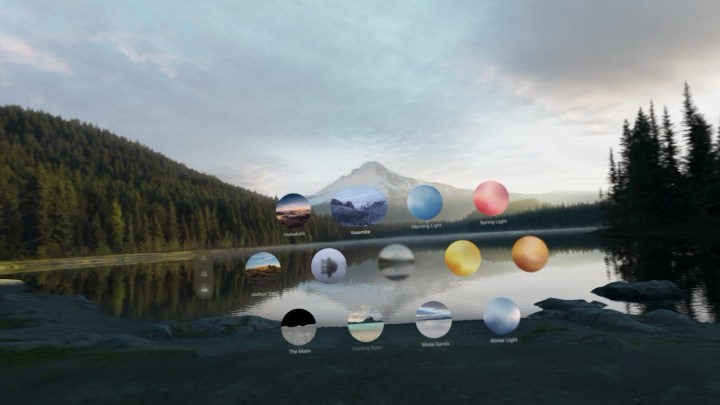
You can go to Joshua Tree, the moon, or even Mount Hood, Oregon, which sits just 54 miles as the crow flies from where I’m sitting right now. I’ve sat right about where the Mount Hood image above was made and enjoyed this view in real life. And I’m not overstating things when I say that, visually and audibly, this is about as close to actually being there as I can imagine experiencing without actually being there.
Of course, I don’t know what it would be like to be on the moon. But the feeling I get when I load up that environment is — it’s eerie. Isolating, almost. It’s not hard to suspend disbelief, which I think is the main reason why you’re hearing so many people raving about how the Vision Pro looks.
Display
But how is Apple pulling this off? Well, here is where I will get into some of the technical stuff a little. The displays Apple is using here are excellent. The pixel pitch — the cramming together of tiny, tiny pixels — is so small that there’s no chance that you’re going to see individual pixels. There are some 11.5 million pixels for each eye. And this is why you hear others talking about the utter lack of screen-door effect. That’s a huge contributor toward creating a convincing representation of reality.
The other most significant factor is that these are OLED displays, which means there are no LED backlights to muck up the image. Blacks are perfectly black, so the contrast is off the charts. It’s technically infinite.
Brightness
Also, due to the proximity of the eye to the screens and the perfectly dark environment — presuming you have a good fit — these displays don’t have to get nearly as bright as a TV or monitor in order to be perceived as bright. In fact, I imagine that was one of Apple’s trickier challenges when calibrating these displays. There’s a razor-thin line to tread between representing reality and maintaining comfort. In real life, spectral highlights can be uncomfortably bright. If you’ve ever caught the sunshine off a ripple in a lake, you know that glint of light can be too much. I don’t think Apple wants to represent reality quite to that level, and so the visual experience isn’t exactly like reality — more of a safely comfortable version of it. But it’s impressive and enjoyable all the same.
I should mention, though, that Apple has headroom here. These displays could get much brighter than they are being allowed to. So, I suppose that as HDR content grading evolves, these displays could look even more hyperrealistic than they do now. That’s exciting to think about — that improving HDR images themselves could result in even more impressive visuals for the Vision Pro.
Color accuracy
I’m not able to measure the output of these displays with the equipment I’ve got, nor do I think I could afford the spectrometer that could do it. But subjectively — based on over 15 years of evaluating displays — I feel pretty comfortable saying that the Vision Pro delivers remarkable color accuracy. I’m not sure it’s targeting D65 white point,– but that’s probably for the better, at least in terms of trying to mimic reality with its displays.
Audio
The visuals are just part of the environment experience, though. Audio plays a huge role as well. I’ll get into the fidelity of the so-called audio pods here in a moment, but right now, I just want to communicate how integral the spatial audio experience is to the environments Apple has created.
Audio can make, break, or transform how we perceive images. I think we’ve all seen viral videos where some dramatic, dark, or even scary movie scene is made comical simply by replacing the soundtrack with jocular music. It works the other way around, too.
Apple has done a masterful job of creating audio accompaniment to images that really puts you there. The grit of shifting sand below your feet while the wash of wind swirls around overhead. The eerie stillness of the air sprinkled with the chirping of birds on Mount Hood. It’s all very enveloping. No doubt, Apple’s implementation of spatial audio is the unsung hero of the Vision Pro experience.
The cinematic experience
But how does all of that translate to watching movies and TV? Is the three-dimensional reality of Apple’s environments successfully transferred to 3D movies? And how does 2D content look? How does it sound compared to a surround sound system? Can the Vision Pro replace or even best a quality home theater?
I spent several hours comparing the Vision Pro movie-watching experience to the home-theater experience I have available in our studio. I’ve got the Sony A95L 65-inch TV here, along with a 98-inch TCL QM8 TV and a Samsung Q990C soundbar surround system, which I can use as a reference point since I’ve compared it to much more elaborate Dolby Atmos surround systems.
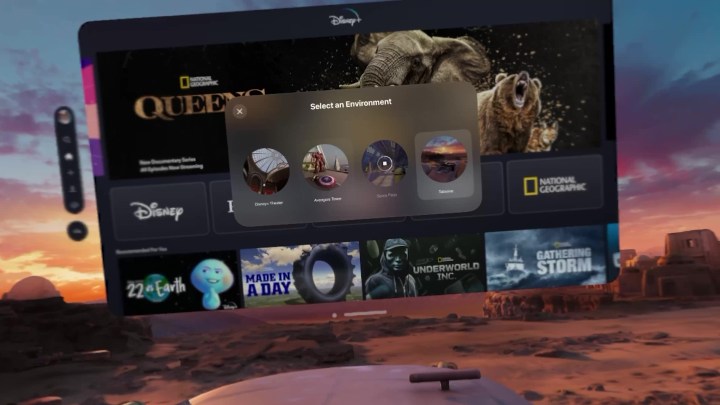
Let me talk about scale. The idea is that the movie screen you see inside the Vision Pro can be scaled up to what should appear to be a 100-foot wide cinema screen. It can support multiple aspect ratios and formats, including Super Panavision 70mm.
Now, I wonder if there’s something wrong with me. I keep hearing folks raving about how it’s just like being at a theater, with the scale just being off the charts. But maybe it’s something about seeing the screen in an “environment” that throws it off for me. It did not have the same effect as going to a theater with a huge screen that exceeds your field of vision.
I just couldn’t get around the feeling that I was really looking at a small screen that was very close to my eyes.
And it’s hard for me to square that with how realistic and enveloping the environments seemed to me. I don’t know. Maybe in time, I’ll relax into it. But I just couldn’t get around the feeling that I was really looking at a small screen that was very close to my eyes. Maybe the problem is that the spatial depth of the environment threw off my perception of the size of the screen. But all I can say is that, for me, it didn’t feel the same as being in a big room, looking at a big screen.
It’s not the spatial audio’s fault, though, that’s for sure. While the scale of the movie viewing experience didn’t exactly jive with me, the Vision Pro is exceptionally good at making it sound like I was in a big cinema room. That’s where the spatial audio really came through for me – it’s an environment with which I am intimately familiar, and I felt like the Vision Pro’s spatial audio really nailed replicating that experience. I do have to say, though, that the fidelity of the sound is far better with AirPods Pro than it is with the audio pods built into the Vision Pro.
The Vision Pro’s built-in speakers do amazing things, don’t get me wrong. But I get the feeling Apple tuned them to work with as wide a variety of anatomical conditions as possible. Everyone’s ears are of different sizes and shapes, and they sit in different places on the head relative to where the audio pods are located on the Vision Pro. There are a lot of variables to take into account. As a result, my experience with the Vision Pro’s audio fidelity was that the treble was a bit harsh or ringy and sibilant, and it lacked the bass I wanted. (That really wasn’t a surprise.) But put in a set of AirPods Pro? Yeah, now we’re cookin’. What an experience!
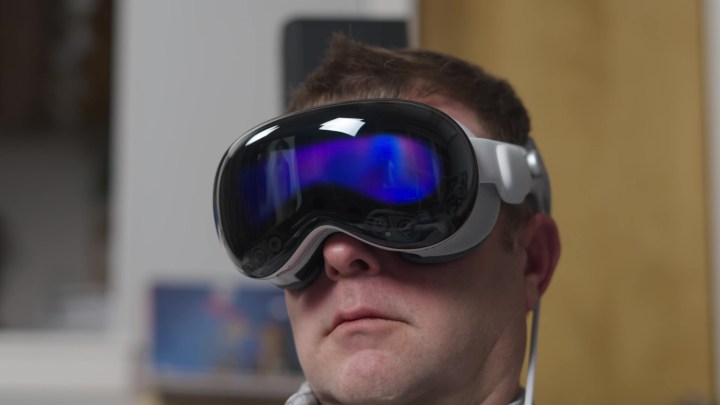
As for video fidelity? I know the Vision Pro has the chops, but somehow, I think the way movies look on the Vision Pro could be even better. It’s excellent as is. But somehow, the Sony A95L pulls off HDR highlights better than the Vision Pro did for me. Maybe the Vision Pro needs to take the training wheels off the peak brightness a bit. More likely, content needs to be graded to look better on the Vision Pro. Because I know the Vision Pro can do it — I’ve seen it in the environments. But somehow, that amazing visual experience doesn’t seem to be carried over for watching movies on Disney+, Netflix, and Max, even with HDR.
The 3D experience is the best 3D movie experience I’ve ever had. But with that acknowledged, it’s clear that it could be even better. In the same way that Apple is shooting its environments and custom content with special cameras? I think Hollywood should do that, too. Yeah, it’s going to be expensive, but movies are already ridiculously expensive to make. Might as well pile this on top. I believe that when 3D video content is made for the Vision Pro, and not just adapted for it, 3D movies will reach a level we’ve always dreamed they should be at.
So, does the Vision Pro beat out a home theater or commercial cinema? In some ways, it does, and in other ways it does not. I’ll get back to that. Because … well, there’s just one more thing.
TrueCut Motion
This is something nobody else is talking about and, at least in the context of the Vision Pro as an entertainment device, I think it is critical. You need to know about this.
Right now, if you pull up the Disney+ app on the Vision Pro and watch Titanic, Avatar, or, to a lesser extent, Avatar: The Way of Water, you can experience something that I think will transform the home movie-watching experience forever. What those three titles I just listed share in common is — well, yes, James Cameron — but also something called TrueCut Motion.
I think the best way to describe TrueCut Motion to you is by calling it VRR, or variable refresh rate, for movies.

When we watch movies at home, we’re watching content that has (usually) been recorded at 24 frames per second (fps). This is the cinema cadence we’ve been enjoying at theaters for decades now. But at home – when watched on TVs with 60Hz or 120Hz refresh rates, that 24 fps content tends to cause some motion problems. Chief among them is judder, where slow panning shots sometimes seem to shudder, or judder, as if frames have gone missing. And then there’s stutter, which is a sort of flashing or strobing effect that happens with TVs that have instant response times. As an image moves across the screen and a dark area becomes a light area, the instant response time of a display’s pixels makes that slow panning shot induce a sort of flashing effect, which we perceive as a stutter or artificial shimmer.
TV manufacturers have tried to deal with these distracting effects with something called frame interpolation, or motion interpolation. But as many folks will be quick to point out — Tom Cruise chief among them — this motion smoothing causes movies to look like cheap soap operas – hence the term soap opera effect.
TrueCut Motion will be making its way into TVs and, ideally, be available from streaming services and on Blu-ray discs.
TrueCut Motion addresses this by allowing movie makers to — well, think of it as changing the frame rate of their movies so that when smoother motion is needed, the frame rate can speed up a bit to keep it smooth and then drop back down so that it can continue to look like a movie.
I think Peter Jackson and Cameron’s always-on 48 -fps movies would have been less off-putting to people if they weren’t always 48 frames per second.
The net effect is outstanding. Finally, those who hate judder and those who hate soap opera effect can unite behind a solution that eliminates judder without introducing soap opera effect.
And you can only see it — again, for now — on Apple Vision Pro. It can be seen in theaters. In fact, if you want to see it for yourself, go check out Kung Fu Panda 4, where TrueCut Motion grading was used for the cinematic release of the movie.

But the real advantage will be for us to watch movies at home. Because TrueCut Motion soon will be making its way into TVs and, ideally, be available from streaming services and on Blu-ray discs. It will take time for the catalog of content using TrueCut motion to grow, but this is a game changer in my book. And Apple Vision Pro is where you can experience it for the first time.
So, is the Vision Pro better than a commercial theater or home theater? It can be. It has some real magic going for it. In some ways, it can be even better. I was definitely wrong, though, when I said it could never stand up because it is so isolating. I do think there is something irreplaceable about the camaraderie involved in enjoying TV and movies in the company of your friends and family — be that at home or in the theater — which is something the Vision Pro can’t allow. I also think the Vision Pro’s greatest achievement is that it enables you to exuberantly enjoy a deeper connection to something you love at times when you are already isolated or alone.
Editors' Recommendations
- You Asked: home theater setup challenges, in-home TV calibration, and is Sony abandoning OLED
- Why Apple Vision Pro will never replace your TV
- 3D is readying for another comeback — and this time it’s personal
- Apple’s Dolby Atmos Music bounty could be a disaster for the format
- Apple has upgraded the AirPods Pro with lossless audio, sort of



